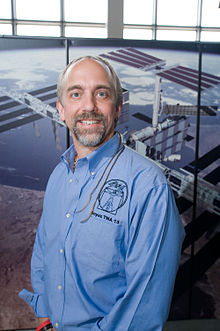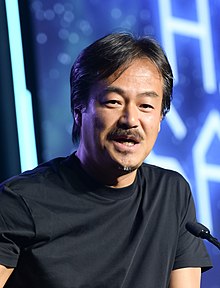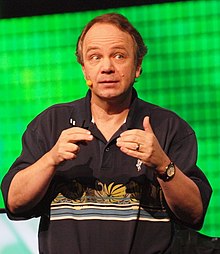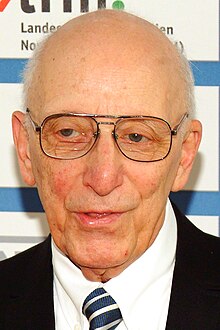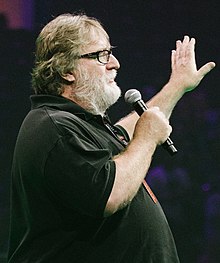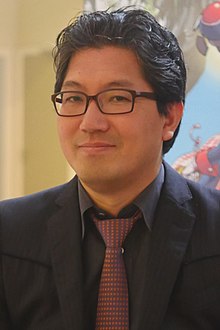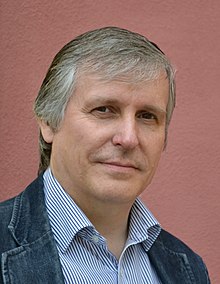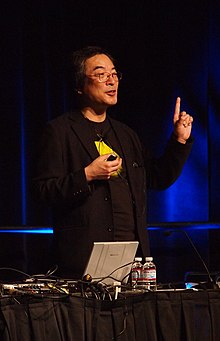Portal:Video games
Portal maintenance status: (April 2019)
|
The Video Games Portal

A video game, sometimes further qualified as a computer game, is an electronic game that involves interaction with a user interface or input device (such as a joystick, controller, keyboard, or motion sensing device) to generate visual feedback from a display device, most commonly shown in a video format on a television set, computer monitor, flat-panel display or touchscreen on handheld devices, or a virtual reality headset. Most modern video games are audiovisual, with audio complement delivered through speakers or headphones, and sometimes also with other types of sensory feedback (e.g., haptic technology that provides tactile sensations). Some video games also allow microphone and webcam inputs for in-game chatting and livestreaming.
Video games are typically categorized according to their hardware platform, which traditionally includes arcade video games, console games, and computer games (which includes LAN games, online games, and browser games). More recently, the video game industry has expanded onto mobile gaming through mobile devices (such as smartphones and tablet computers), virtual and augmented reality systems, and remote cloud gaming. Video games are also classified into a wide range of genres based on their style of gameplay and target audience. (Full article...)
Featured articles – load new batch
-
Image 1Turok: Dinosaur Hunter is a first-person shooter video game developed by Iguana Entertainment and published by Acclaim for the Nintendo 64 console and Microsoft Windows. It was released in 1997 in North America and Europe. Turok is an adaptation of the Valiant Comics comic book series of the same name. The player controls Turok, a Native American warrior, who must stop the evil Campaigner from conquering the universe with an ancient and powerful weapon.
As Acclaim's first title for the Nintendo 64, Turok was part of a strategy to develop games internally and license merchandise; Acclaim acquired the rights to Turok when it purchased Valiant Comics in 1994, renaming it Acclaim Comics. Suffering from cash flow problems and falling sales, Acclaim came to rely on Turok as its best hope for a financial turnaround. Iguana pushed the Nintendo 64's graphics capabilities to its limits, and were forced to compress or cut elements to fit the game on its 8 megabyte cartridge. Bugs delayed the game's release from September 1996 to January 1997.
Critical reception of Turok was highly positive. Becoming one of the most popular games for the console on release, Turok won praise for its graphics and evolution of the genre. Complaints centered on graphical slowdowns caused by multiple enemies appearing onscreen and occasionally awkward controls. The game sold 1.5 million copies and boosted sales of the Nintendo 64. Turok spawned a video game franchise that includes a direct sequel, titled Turok 2: Seeds of Evil, in 1998, and a prequel, Turok: Evolution, in 2002. A remastered version of the game by Nightdive Studios was released through digital distribution for Microsoft Windows in 2015, followed by an OS X release in 2016, Xbox One and Linux releases in 2018, a Nintendo Switch release in 2019, and a PlayStation 4 release in 2021. The original game was also re-released on the Nintendo Switch Online + Expansion Pack via the Mature 17+ app in June 2024. (Full article...) -
Image 2God of War: Ascension is a 2013 action-adventure game developed by Santa Monica Studio and published by Sony Computer Entertainment for the PlayStation 3. Released in March 2013, it is the seventh installment in the God of War series and a prequel to the entire series. Loosely based on Greek mythology, it is set in ancient Greece with vengeance as its central motif. The player controls the protagonist, Kratos, the former servant of the God of War Ares, who tricked Kratos into killing his wife and daughter. In response to this tragedy, Kratos renounced Ares, breaking his blood oath to the god. Kratos was, therefore, imprisoned and tortured by the three Furies, guardians of honor and enforcers of punishment. Helped by the oath keeper, Orkos, Kratos escapes his imprisonment and confronts the Furies, aiming to free himself of his bond to Ares.
The gameplay is similar to previous installments, focusing on combo-based combat with the player's main weapon, the Blades of Chaos, and other weapons acquired by the game's World Weapons mechanic. It continues the use of quick time events from previous entries but also utilizes a promptless free-form system. Four magical attacks and a power-enhancing ability can be used as alternative combat options, and the game features puzzles and platforming elements. The game also features a redesigned combat system, gameplay mechanics not available in previous installments, and downloadable content. Notably, Ascension is the only installment in the series to include multiplayer, which is online-only and features modes for both competitive and cooperative play. From October 2012 to March 2013, a social experience was available online in the form of a graphic novel titled Rise of the Warrior, a prequel story that tied into the game's single-player and multiplayer modes. Ascension was the last released game in the series to be based on Greek mythology and also the last one to feature Terrence C. Carson as the voice of Kratos. The franchise shifted to Norse mythology with 2018's God of War, with Christopher Judge assuming the role of Kratos.
God of War: Ascension received generally positive reviews from critics, who praised its fundamental gameplay and spectacle as true to the series, although the story was deemed to be less compelling than in previous installments. The game's multiplayer element received mixed responses: although reviewers found that the gameplay translated well into the multiplayer setting, they criticized the balance and depth of combat. Ascension sold less than its predecessor, with over 3 million units shipped and received no awards, but it did, however, receive several nominations, including "Outstanding Achievement in Videogame Writing" at the Writers Guild of America Videogame Awards and the Academy of Interactive Arts & Sciences award for "Outstanding Achievement in Sound Design". (Full article...) -
Image 3Riven: The Sequel to Myst is a puzzle adventure video game, the second in the Myst series of games. Developed by Cyan Worlds, it was initially published by Red Orb Entertainment, a division of Broderbund. Riven was distributed on five compact discs and released for Mac and Windows personal computers on October 31, 1997, in North America; it was later released on a single DVD-ROM in 1998. Riven was also ported to several other platforms. The story of Riven is set after the events of Myst. Having been rescued from the efforts of his sons, Atrus enlists the help of the player character to free his wife from his power-hungry father, Gehn. Riven takes place almost entirely on the Age of Riven, a world slowly falling apart due to Gehn's destructive rule.
Development of Riven began soon after Myst became a success, and spanned more than three years. In an effort to create a visual style distinct from that of Myst, director Robyn Miller and his brother, producer Rand Miller, recruited former Aladdin production designer Richard Vander Wende as a co-director. Broderbund employed a multimillion-dollar advertising campaign to publicize the game's release.
Riven was praised by reviewers, with the magazine Salon proclaiming that the game approaches the level of art. Critics positively noted the puzzles and immersive experience of the gameplay, though publications such as Edge felt that the nature of point-and-click gameplay limited the title heavily. The best-selling game of 1997, Riven sold 1.5 million copies in one year. After the game's release, Robyn Miller left Cyan to form his own development studio, ending the professional partnership of the two brothers. Rand stayed at Cyan and continued to work on Myst-related products including The Myst Reader and the real-time rendered game Uru: Ages Beyond Myst. The next entry in the Myst series, Myst III: Exile, was developed by Presto Studios and published by Ubisoft. A remake of the game, recreating the world in fully explorable 3D and supporting both normal and virtual reality, was released in June 2024. (Full article...) -
Image 4The development of The Elder Scrolls IV: Oblivion began in 2002, immediately after its predecessor, The Elder Scrolls III: Morrowind, was published. Rumors of a sequel to Morrowind started circulating in June 2004; the sequel's title was identified on September 10, 2004, the date of its official announcement. Oblivion was developed by Bethesda Game Studios, and the initial Xbox 360 and personal computer (PC) releases were co-published by Bethesda Softworks and Take-Two Interactive's subsidiary, 2K Games. According to interviews with Bethesda staff, the publisher-developer relationship—one of the few independent relations in the industry—worked well, and Bethesda was not subject to excessive corporate guidance. Initially scheduled for a November 22, 2005, release, in tandem with the Xbox 360's launch, Oblivion was delayed to a March 21, 2006, release for Windows PCs and the Xbox 360.
Developers working on Oblivion focused on providing a tighter storyline, with fewer filler quests and more developed characters. The developers sought to make information in the game world more accessible to players, making the game easier to pick up and play. Oblivion features improved AI (which Bethesda calls Radiant AI), improved physics courtesy of the Havok physics engine, and impressive graphics, taking advantage of advanced lighting and shader routines like high-dynamic-range rendering (HDR) and specular mapping. Bethesda developed and implemented procedural content creation tools in the creation of Oblivion's terrain, leading to landscapes that are more complex and realistic than those of past titles, with less of a drain on Bethesda's staff.
A PlayStation 3 version of Oblivion was released on March 20, 2007, in North America, and April 27, 2007, in Europe, following delays similar to those for the Xbox 360 release. The PlayStation 3 release was touted for its improvement over the graphics of the PC and Xbox 360 versions, although some of the improved shader routines optimized for the PlayStation 3 release were set to be ported over to the other releases through patches. A plan to distribute content through downloads paid by micropayment was initially met with criticism by customers due to its alleged low value, but later releases—at a reduced price, and with more content—proved more popular. (Full article...) -
Image 5Doom is a first-person shooter game developed and published by id Software. Released on December 10, 1993, for DOS, it is the first installment in the Doom franchise. The player assumes the role of a space marine, later unofficially referred to as Doomguy, fighting through hordes of undead humans and invading demons. The game begins on the moons of Mars and finishes in hell, with the player traversing each level to find its exit or defeat its final boss. It is an early example of 3D graphics in video games, and has enemies and objects as 2D images, a technique sometimes referred to as 2.5D graphics.
Doom was the third major independent release by id Software, after Commander Keen (1990–1991) and Wolfenstein 3D (1992). In May 1992, id started developing a darker game focused on fighting demons with technology, using a new 3D game engine from the lead programmer, John Carmack. The designer Tom Hall initially wrote a science fiction plot, but he and most of the story were removed from the project, with the final game featuring an action-heavy design by John Romero and Sandy Petersen. Id published Doom as a set of three episodes under the shareware model, marketing the full game by releasing the first episode free. A retail version with an additional episode was published in 1995 by GT Interactive as The Ultimate Doom.
Doom was a critical and commercial success, earning a reputation as one of the best and most influential video games of all time. It sold an estimated 3.5 million copies by 1999, and up to 20 million people are estimated to have played it within two years of launch. It has been termed the "father" of first-person shooters and is regarded as one of the most important games in the genre. It has been cited by video game historians as shifting the direction and public perception of the medium as a whole, as well as sparking the rise of online games and communities. It led to an array of imitators and clones, as well as a robust modding scene and the birth of speedrunning as a community. Its high level of graphic violence led to controversy from a range of groups. Doom has been ported to a variety of platforms both officially and unofficially and has been followed by several games in the series, including Doom II (1994), Doom 64 (1997), Doom 3 (2004), Doom (2016), Doom Eternal (2020), and Doom: The Dark Ages (2025), as well as the films Doom (2005) and Doom: Annihilation (2019). (Full article...) -
Image 6Portal is a 2007 puzzle-platform game developed and published by Valve. It was originally released in a bundle, The Orange Box, for Windows, Xbox 360 and PlayStation 3, and has been since ported to other systems, including Mac OS X, Linux, Android (via Nvidia Shield), and Nintendo Switch.
Portal consists primarily of a series of puzzles that must be solved by teleporting the player's character and simple objects using "the Aperture Science Handheld Portal Device", also referred to as the "portal gun", a device that can create intra-spatial portals between two flat planes. The player-character, Chell, is challenged and taunted by an artificial intelligence named GLaDOS (Genetic Lifeform and Disk Operating System) to complete each puzzle in the Aperture Science Enrichment Center using the portal gun with the promise of receiving cake when all the puzzles are completed. The Source Engine's physics system allows kinetic energy to be retained through portals, requiring creative use of portals to maneuver through the test chambers. This gameplay element is based on a similar concept from the game Narbacular Drop; many of the team members from the DigiPen Institute of Technology who worked on Narbacular Drop were hired by Valve for the creation of Portal, making it a spiritual successor to the game.
Portal was acclaimed as one of the most original games of 2007, despite some criticism for its short duration. It received praise for its originality, unique gameplay and a dark story and sense of comedy. GLaDOS, voiced by Ellen McLain in the English-language version, received acclaim for her unique characterization, and the end credits song "Still Alive", written by Jonathan Coulton for the game, was praised for its original composition and humor. Portal is often cited as one of the greatest video games ever made. Excluding Steam download sales, over four million copies of the game have been sold since its release, spawning official merchandise from Valve including a model portal gun and plush Companion Cubes, as well as fan recreations of the cake. (Full article...) -
Image 7Metroid Prime 2: Echoes is a 2004 adventure game developed by Retro Studios and published by Nintendo for the GameCube. The sequel to Metroid Prime (2002) and the first Metroid game with a multiplayer feature, Echoes was released in North America, Europe and Australia in 2004 and in Japan under the name Metroid Prime 2: Dark Echoes in May 2005.
The story follows bounty hunter Samus Aran after she is sent to rescue Galactic Federation Marines from a ship near Aether, a planet inhabited by a race known as the Luminoth. She discovers that the troops were slaughtered by the Ing, a hostile race that came from an alternate dimension of Aether. Samus must travel to four temples to ensure the destruction of the evil Ing, while battling them, wild creatures, Space Pirates, and her mysterious doppelgänger Dark Samus.
Retro sought to differentiate Echoes with a heavier focus on story-telling and new gameplay mechanics. Nintendo launched a viral marketing campaign that included several websites written as if taking place in the Metroid universe. The single-player mode was acclaimed for its graphics, atmosphere and music, though its steep difficulty and multiplayer mode were met less positively. (Full article...) -
Image 8Doom is a 2016 first-person shooter video game developed by id Software and published by Bethesda Softworks. The game is the first major installment in the Doom series since 2004's Doom 3 and is a reboot of the franchise. It was released for PlayStation 4, Windows, and Xbox One in May 2016. A port for Nintendo Switch was co-developed with Panic Button and released in November 2017, and a version for Google Stadia was released in August 2020. Players take the role of an unnamed space marine, known as the "Doom Slayer", as he battles demonic forces within an energy-mining facility on Mars and in Hell.
Doom was announced as Doom 4 in 2008, and that version underwent an extensive development cycle with different builds and designs before the game was restarted in 2011 and re-revealed as simply Doom in 2014. It was tested by customers who pre-ordered the 2014 MachineGames game Wolfenstein: The New Order and the general public. Mick Gordon composed the music, with contributions by Richard Devine. The game also has an online multiplayer component and a level editor known as "SnapMap", co-developed with Certain Affinity and Escalation Studios respectively.
Doom was well received by critics and players. The single-player campaign, graphics, soundtrack, and gameplay received considerable praise, whereas the multiplayer mode drew significant criticism. It was the second best-selling video game in North America and the United Kingdom in the week of its release and sold over 500,000 copies for PCs by the end of May 2016. A sequel, Doom Eternal, was released in March 2020. A prequel, Doom: The Dark Ages, is set to be released in 2025. (Full article...) -
Image 9Super Mario 64 is a 1996 platform game developed and published by Nintendo for the Nintendo 64. It was released in Japan and North America in 1996 and PAL regions in 1997. It is the first Super Mario game to feature 3D gameplay, combining traditional Super Mario gameplay, visual style, and characters in a large open world. In the game, Bowser, the primary antagonist of the Super Mario franchise, invades Princess Peach's castle and hides the castle's sources of protection, the Power Stars, in many different worlds inside magical paintings. As Mario, the player collects Power Stars to unlock enough of Princess Peach's castle to get to Bowser and rescue Princess Peach.
Director Shigeru Miyamoto conceived a 3D Super Mario game during the production of Star Fox (1993). Development lasted nearly three years: about one year on design and twenty months on production, starting with designing the virtual camera system. The team continued with illustrating the 3D character models—at the time a relatively unattempted task—and refining sprite movements. The sound effects were recorded by Yoji Inagaki and the score was composed by Koji Kondo.
Super Mario 64 was highly anticipated by video game journalists and audiences, boosted by advertising campaigns and showings at the 1996 E3 trade show. It received critical acclaim, with reviewers praising its ambition, visuals, level design, and gameplay, though some criticized its virtual camera system. It is the best-selling Nintendo 64 game, with nearly twelve million copies sold by 2015. (Full article...) -
Image 10Flight Unlimited is a 1995 aerobatic flight simulator video game developed and published by LookingGlass Technologies. It allows players to pilot reproductions of real-world aircraft and to perform aerobatic maneuvers. They may fly freely, race through floating rings against a timer or take lessons from a virtual flight instructor. The instructor teaches basic and advanced techniques, ranging from rudder turns to maneuvers such as the tailslide, Lomcovák and Immelmann turn.
Flight Unlimited was the first self-published game released by Looking Glass Technologies. It was intended to establish the company as a video game publisher and to compete with flight simulator franchises such as Microsoft Flight Simulator. Project leader Seamus Blackley, a particle physicist and amateur pilot, conceived the game in 1992. He felt that other flight simulators failed to convey the experience of real flight, and he reacted by coding a simulated atmosphere for Flight Unlimited based on real-time computational fluid dynamics. Aerobatic pilot Michael Goulian endorsed the game and assisted the team in making it more true to life.
Flight Unlimited received positive reviews from critics and was a commercial success; its sales exceeded 780,000 copies by 2002. Reviewers lauded its realism, flight instruction, graphics and sense of flight, but some criticized its high system requirements. The game was followed by two sequels: Flight Unlimited II (1997) and Flight Unlimited III (1999). A combat-oriented successor, Flight Combat, was released in 2002 as Jane's Attack Squadron after a series of setbacks. Soon after Flight Unlimited's completion, Blackley was fired from Looking Glass. He went on to design Jurassic Park: Trespasser at DreamWorks Interactive and later spearhead the Xbox project at Microsoft. (Full article...)
Did you know... - show different entries
- ... that Kamibox's video game A Joke That's Worth $0.99 is permanently on special offer because Itch.io does not allow $0.99 as a regular price?
- ... that the video game JFK Reloaded recreates the assassination of John F. Kennedy from the perspective of the killer?
- ... that Goodboy Galaxy was the first commercially released video game for the Game Boy Advance in more than 13 years?
- ... that match-three video games such as Candy Crush Saga are often considered to be Bejeweled clones?
- ... that Elena from the video game series Street Fighter uses a capoeira fighting style, for which the development team used travel videos as reference material as they had no experience with the style?
- ... that a pink skin for Mercy in the video game Overwatch helped raise more than $12 million for breast cancer research?
- ... that LittleBigPlanet, a video game that allows the player to create levels, coincided with the rise of user-generated content?
- ... that MicroProse was formed to publish Hellcat Ace after Sid Meier boasted that he could design a better video game than Red Baron in a week?
- ... that Kainé from the video game series Nier was created in response to a female staff member's vague wish for a "male heroine"?
- ... that the contrabass trombone has experienced a revival in film music and video game soundtracks?
- ... that classified documents of the United States were partially leaked onto a Discord server for the video game Minecraft?
- ... that Justin Yu, the current Classic Tetris World Champion, is also a cellist in MIT's video game orchestra?
Selected biography – load new batch
-
Image 1Shigeru Miyamoto (Japanese: 宮本 茂, Hepburn: Miyamoto Shigeru, born November 16, 1952) is a Japanese video game designer, producer and game director at Nintendo, where he serves as one of its representative directors as an executive since 2002. Widely regarded as one of the most accomplished and influential designers in video games, he is the creator of some of the most acclaimed and best-selling game franchises of all time, including Mario, The Legend of Zelda, Donkey Kong, Star Fox and Pikmin. More than 1 billion copies of games featuring franchises created by Miyamoto have been sold.
Born in Sonobe, Kyoto, Miyamoto graduated from Kanazawa Municipal College of Industrial Arts. He originally sought a career as a manga artist, until developing an interest in video games. With the help of his father, he joined Nintendo in 1977 after impressing the president, Hiroshi Yamauchi, with his toys. He helped create art for the arcade game Sheriff, and was later tasked with designing a new arcade game, leading to the 1981 game Donkey Kong. (Full article...) -
Image 2
Richard Allen Garriott (born 4 July 1961) is a British-born American video game developer, entrepreneur and private astronaut.
Garriott, who is the son of NASA astronaut Owen Garriott, was originally a game designer and programmer, and is now involved in a number of aspects of computer-game development. On October 12, 2008, Garriott flew aboard the Soyuz TMA-13 mission to the International Space Station as a private astronaut, returning 12 days later aboard Soyuz TMA-12. He became the second space traveler, and first from the United States, to have a parent who was also a space traveler. During his ISS flight, he filmed a science fiction movie Apogee of Fear. (Full article...) -
Image 3
Anita Sarkeesian (/sɑːrˈkiːziən/ sar-KEE-zee-ən; born 1983) is a Canadian-American feminist media critic. She is the founder of Feminist Frequency, a website that hosts videos and commentary analyzing portrayals of women in popular culture. Her video series Tropes vs. Women in Video Games, examines tropes in the depiction of female video game characters.
Media scholar Soraya Murray calls Sarkeesian emblematic of "a burgeoning organized feminist critique" of stereotyped and objectified portrayals of women in video games.
In 2012, Sarkeesian was targeted by an online harassment campaign following her launch of a Kickstarter project to fund the Tropes vs. Women in Video Games series. The threats and harassment generated widespread media attention, and resulted in the project far exceeding its funding goal. The media coverage placed Sarkeesian at the center of discussions about misogyny in video game culture and online harassment. She has spoken to TEDxWomen, XOXO Festival, and the United Nations' Broadband Working Group on Gender, and appeared on The Colbert Report discussing her experiences of harassment and the challenge of attempting to improve gender inclusivity in gaming culture and the media. (Full article...) -
Image 4
John Bruce Thompson (born July 25, 1951) is an American activist and disbarred attorney. As an attorney, Thompson focused his legal efforts against what he perceives as obscenity in modern culture. Thompson gained recognition as an anti-video game activist, criticizing the content of video games and their alleged effects on children. He also targeted rap music and radio personality Howard Stern.
Thompson's legal career was further recognized for his actions against the Florida Bar, including challenging its constitutionality in 1993. In 2008, he was permanently disbarred by the Supreme Court of Florida for inappropriate conduct, including making false statements to tribunals and disparaging and humiliating litigants. (Full article...) -
Image 5
Geoff Keighley (/ˈkiːli/ KEE-lee; born (1978-06-24)June 24, 1978) is a Canadian video game journalist and television presenter, best known for his role as the host of several video game industry conferences and presentations. He is the executive producer and host of the Game Awards since its inception in 2014, having previously served as the executive producer of the Spike Video Game Awards. He also hosts and produces Summer Game Fest, and has hosted live events for trades fairs Gamescom and the now-defunct E3.
He previously hosted the video game show GameTrailers TV, and G4tv.com. Keighley is also a freelance writer whose work has appeared in Kotaku among other publications. His multi-media series The Final Hours, originally an article series published by GameSpot, features in-depth interviews and behind-the-scenes with developers of popular franchises like Portal, Mass Effect and Tomb Raider. (Full article...) -
Image 6Wright speaking at the 2010 Game Developers Conference
William Ralph Wright (born January 20, 1960) is an American video game designer and co-founder of the game development company Maxis, which later became part of Electronic Arts. In April 2009, he left EA to run Stupid Fun Club Camp, an entertainment think tank in which Wright and EA are principal shareholders.
The first computer game Wright designed was Raid on Bungeling Bay in 1984, but it was SimCity that brought him to prominence. The game was published by Maxis, which Wright co-formed with Jeff Braun. Wright continued to innovate on the game's central theme of simulation with numerous other titles including SimEarth and SimAnt. (Full article...) -
Image 7Gunpei Yokoi (横井 軍平, Yokoi Gunpei, 10 September 1941 – 4 October 1997), sometimes transliterated as Gumpei Yokoi, was a Japanese toy maker and video game designer. As a long-time Nintendo employee, he was best known as creator of the Game & Watch handheld system, inventor of the cross-shaped Control Pad, the original designer of the Game Boy, and producer of a few long-running and critically acclaimed video game franchises such as Metroid and Kid Icarus. (Full article...)
-
Image 8Hironobu Sakaguchi (坂口 博信, Sakaguchi Hironobu, born November 25, 1962) is a Japanese game designer, director, producer, and writer. Originally working for Square (later Square Enix) from 1983 to 2003, he departed the company and founded independent studio Mistwalker in 2004. He is known as the creator of the Final Fantasy franchise, in addition to other titles during his time at Square. At Mistwalker, he is known for creating the Blue Dragon and Terra Battle series among several standalone titles, moving away from home consoles and creating titles for mobile platforms.Sakaguchi at the 2015 Game Developers Choice Awards
Originally intending to become a musician, he briefly studied electronics and programming, joining Square as a part-time employee, then later a full-time employee when Square became an independent company in 1986. He led the development of several titles before helping to create the original Final Fantasy, which proved highly successful and cemented his status within the company. Following the financial failure of Final Fantasy: The Spirits Within, his debut as a film director, Sakaguchi withdrew from Square's management and eventually resigned in 2003. He continued his game career through Mistwalker, first co-developing projects through external partners and then smaller in-studio mobile projects. (Full article...) -
Image 9Meier at the 2010 Game Developers Conference
Sidney K. Meier (/ˈmaɪər/ MIRE; born February 24, 1954) is an American businessman and computer programmer. A programmer, designer, and producer of several strategy video games and simulation video games, including the Civilization series, Meier co-founded MicroProse in 1982 with Bill Stealey and is the Director of Creative Development of Firaxis Games, which he co-founded with Jeff Briggs and Brian Reynolds in 1996. For his contributions to the video game industry, Meier was inducted into the Academy of Interactive Arts and Sciences Hall of Fame. (Full article...) -
Image 10
Ralph Henry Baer (born Rudolf Heinrich Baer; March 8, 1922 – December 6, 2014) was an American inventor, game developer, and engineer.
Baer's Jewish family fled Germany just before World War II and Baer served the American war effort, gaining an interest in electronics shortly thereafter. Through several jobs in the electronics industry, he was working as an engineer at Sanders Associates (now BAE Systems) in Nashua, New Hampshire, when he conceived the idea of playing games on a television screen around 1966. With support of his employers, he worked through several prototypes until he arrived at a "Brown Box" that would later become the blueprint for the first home video game console, licensed by Magnavox as the Magnavox Odyssey. Baer continued to design several other consoles and computer game units, including contributing to design of the Simon electronic game. Baer continued to work in electronics until his death in 2014, with over 150 patents to his name. (Full article...) -
Image 11Satoshi Tajiri (Japanese: 田尻 智, Hepburn: Tajiri Satoshi, born August 28, 1965) is a Japanese video game designer and director who is the creator of the Pokémon franchise and the co-founder and president of video game developer Game Freak.
A fan of arcade games in his youth, Tajiri wrote for and edited his own video gaming fanzine Game Freak with Ken Sugimori, before evolving it into a development company of the same name. Tajiri claims that the joining of two Game Boys via a link cable inspired him to create a game which embodied the collection and companionship of his childhood hobby, insect collecting. The game, which became Pokémon Red and Pokémon Green, took six years to complete and went on to spark a multibillion-dollar franchise which reinvigorated Nintendo's handheld gaming scene. Tajiri continued to work as director for the Pokémon series until the development of Pokémon Ruby and Sapphire, when he changed his role to executive producer, which he holds to this day. (Full article...) -
Image 12Shinji Mikami (三上 真司, Mikami Shinji, born August 11, 1965) is a Japanese video game designer, director, and producer. Starting his career at Capcom in 1990, he has worked on many of the company's most successful games. He directed the first installment of the Resident Evil series in 1996 and the first installment of the Dino Crisis series in 1999, both survival horror games. He returned to Resident Evil to direct the remake of the first game in 2002 and the survival horror third-person shooter Resident Evil 4 in 2005. In 2006, he directed his final Capcom game God Hand, a beat 'em up action game. Mikami founded PlatinumGames in 2006 and directed the third-person shooter Vanquish in 2010. That same year he left the studio and founded a new studio Tango Gameworks and directed the survival horror game The Evil Within in 2014. He has also served the roles of producer and executive producer for many games. In 2023, he left the studio and founded a new studio KAMUY in 2024.
In 2009, he was chosen by IGN as one of the top 100 game creators of all time. (Full article...) -
Image 13
Gabe Logan Newell (born November 3, 1962), also known by his nickname Gaben, is an American video game developer and businessman. He is the president and co-founder of the video game company Valve Corporation.
Newell was born in Colorado and grew up in Davis, California. He attended Harvard University in the early 1980s but dropped out to join Microsoft, where he helped create the first versions of the Windows operating system. In 1996, he and Mike Harrington left Microsoft to found Valve and fund the development of their first game, Half-Life (1998). Harrington sold his stake in Valve to Newell and left in 2000. Newell led the development of Valve's digital distribution service, Steam, which launched in 2003 and controlled most of the market for downloaded PC games by 2011. (Full article...) -
Image 14Satoru Iwata (Japanese: 岩田 聡, Hepburn: Iwata Satoru, December 6, 1959 – July 11, 2015) was a Japanese businessman, video game programmer, video game designer, and producer. He was the fourth president and chief executive officer (CEO) of Nintendo from 2002 until his death in 2015. Iwata was a major contributor in broadening the appeal of video games by focusing on novel and entertaining games rather than top-of-the-line hardware.Iwata at Game Developers Conference in 2011
Born in Sapporo, Iwata expressed interest in video games from an early age and created his first simple game while in high school. He majored in computer science at the Tokyo Institute of Technology. In 1980, he joined the game developer HAL Laboratory while attending the university. At HAL, he worked as a programmer and closely collaborated with Nintendo, producing his first commercial game in 1983. Games to which he contributed include EarthBound and many games in the Kirby series. Following a downturn and near-bankruptcy, Iwata became the president of HAL in 1993 at the insistence of Nintendo president Hiroshi Yamauchi and brought financial stability. In the following years, he worked in the development of the Pokémon and Super Smash Bros. series. Iwata joined Nintendo as the head of its corporate planning division in 2000. (Full article...) -
Image 15Hideo Kojima (小島 秀夫, Kojima Hideo, born August 24, 1963) is a Japanese video game designer. Regarded as one of the first auteurs of video games, he developed a strong passion for film and literature during his childhood and adolescence, which in turn has had a significant influence on his games. In 1986, Kojima joined Konami, for which he directed, designed and wrote Metal Gear (1987) for the MSX2, the game that laid the foundations for the stealth genre and the Metal Gear franchise, his best known and most acclaimed work. At Konami, he also produced the Zone of the Enders series, as well as designing and writing Snatcher (1988) and Policenauts (1994), graphic adventure games regarded for their cinematic presentation.
Kojima founded Kojima Productions within Konami in 2005, and he was appointed vice president of Konami Digital Entertainment in 2011. Following his departure from Konami in 2015, he refounded Kojima Productions as an independent studio; his first game outside Konami, Death Stranding, was released in 2019. (Full article...) -
Image 16Yuji Naka (中 裕司, Naka Yūji, born September 17, 1965), credited in some games as YU2, is a Japanese video game developer. He is the co-creator of the Sonic the Hedgehog series and was the president of Sonic Team at Sega until his departure in 2006.
Naka joined Sega in 1984 and worked on games including Girl's Garden (1985) and Phantasy Star II (1989). He was the lead programmer of the original Sonic games on the Mega Drive in the early 1990s, which greatly increased Sega's market share. After developing Sonic the Hedgehog (1991) in Japan, Naka moved to California to develop Sonic the Hedgehog 2 (1992), Sonic the Hedgehog 3 (1994) and Sonic & Knuckles (1994) with Sega Technical Institute. (Full article...) -
Image 17
Nolan Kay Bushnell (born February 5, 1943) is an American businessman and electrical engineer. He established Atari, Inc. and the Chuck E. Cheese's Pizza Time Theatre chain. He has been inducted into the Video Game Hall of Fame and the Consumer Electronics Association Hall of Fame, received the BAFTA Fellowship and the Nations Restaurant News "Innovator of the Year" award, and was named one of Newsweek's "50 Men Who Changed America". He has started more than 20 companies and is one of the founding fathers of the video game industry. He is on the board of Anti-Aging Games. In 2012, he founded an educational software company called Brainrush, that is using video game technology in educational software.
He is credited with Bushnell's Law, an aphorism about games that are "easy to learn and difficult to master" being rewarding. (Full article...) -
Image 18
Richard Allan Bartle (born 10 January 1960) is a British writer, professor and game researcher in the massively multiplayer online game industry. He co-created MUD1 (the first MUD) in 1978, and is the author of the 2003 book Designing Virtual Worlds. (Full article...) -
Image 19Yu Suzuki (鈴木 裕, Suzuki Yū, born June 10, 1958) is a Japanese game designer, producer, programmer, and engineer, who headed Sega's AM2 team for 18 years. Considered one of the first auteurs of video games, he has been responsible for a number of Sega's arcade hits, including three-dimensional sprite-scaling games that used "taikan" motion simulator arcade cabinets, such as Hang-On, Space Harrier, Out Run and After Burner, and pioneering polygonal 3D games such as Virtua Racing and Virtua Fighter, which are some of the games besides others from rival companies during that era credited with popularizing 3D graphics in video games; as well as the critically acclaimed Shenmue series. As a hardware engineer, he led the development of various arcade system boards, including the Sega Space Harrier, Model 1, Model 2 and Model 3, and was involved in the technical development of the Dreamcast console and its corresponding NAOMI arcade hardware.Suzuki at the 2011 Game Developers Conference
In 2003, Suzuki became the sixth person to be inducted into the Academy of Interactive Arts and Sciences' Hall of Fame. IGN listed him at #9 in their Top 100 Game Creators of All Time list. In 2011, he received the Pioneer Award at the Game Developers Choice Awards. (Full article...) -
Image 20Tokuro Fujiwara (藤原 得郎, Fujiwara Tokurō, born April 7, 1961), sometimes credited as Professor F or Arthur King, is a Japanese video game designer, involved in the development of many classic Capcom video games. He directed early Capcom titles such as the run-and-gun shooter Commando (1985), the platformers Ghosts 'n Goblins (1985) and Bionic Commando (1987), and the survival horror game Sweet Home (1989). He was also a main producer for the Mega Man series and worked on the CP System arcade game Strider (1989). He also conceived of Resident Evil as a remake of his earlier game Sweet Home and worked on the game as general producer. He worked as the general manager of the Capcom Console Games Division from 1988 to 1996.
After working at Capcom for thirteen years, he left the company to form his own studio, Whoopee Camp. His latest game was Ghosts 'n Goblins Resurrection for former employer Capcom. He is notorious for making his titles difficult for the average video game player and strict personality among peers. IGN listed Fujiwara at number 13 in its "Top 100 Game Creators of All Time" list. (Full article...) -
Image 21Persson at the 2016 Game Developers Conference
Markus Alexej Persson (/ˈpɪərsən/ ⓘ PEER-sən, Swedish: [ˈmǎrːkɵs ˈpæ̌ːʂɔn] ⓘ; born 1 June 1979), also known as Notch, is a Swedish video game programmer and designer. He is the creator of Minecraft, which is the best-selling video game in history. He founded the video game development company Mojang Studios in 2009.
Persson began developing video games at an early age. His commercial success began after he published an early version of Minecraft in 2009. Prior to the game's official retail release in 2011, it had sold over ten million copies. After this point Persson stood down as the lead designer and transferred his creative authority to Jens Bergensten. In September 2014 Persson announced on his personal website that he had concluded he "[didn't have the connection to his fans he thought he had]", that he had "become a symbol", and that he did not wish to be responsible for Mojang's increasingly large operation. He left Mojang in November of that year, selling his company to Microsoft reportedly for US$2.5 billion. The acquisition made Persson a billionaire. (Full article...) -
Image 22
Alexey Leonidovich Pajitnov (born April 16, 1955) is a Russian and American computer engineer and video game designer. He is best known for creating, designing, and developing Tetris in 1985 while working at the Dorodnitsyn Computing Centre under the Academy of Sciences of the Soviet Union (now the Russian Academy of Sciences). After Tetris was released internationally in 1987, he released a sequel in 1989, entitled Welltris.
In 1991, he moved to the United States and later became a U.S. citizen. In 1996, Pajitnov founded The Tetris Company alongside Dutch video game designer Henk Rogers. Despite the game's high popularity, Pajitnov did not receive royalties from Tetris prior to this time. (Soviet Union had disintegrated by 1991). (Full article...) -
Image 23
Steven Scott Ritchie (born February 13, 1950) is an American pinball and video game designer. His career began in the 1970s. Ritchie holds the record for best-selling pinball designer in history. He has been called "The Master of Flow" due to the emphasis in his designs on ball speed, loops, and long smooth shots. Ritchie was also the original voice of Shao Kahn in the Mortal Kombat fighting game series, serving as the announcer of Mortal Kombat II (1993), Mortal Kombat 3 (1995), and the updates to Mortal Kombat 3. He is the older brother of fellow pinball designer Mark Ritchie. (Full article...) -
Image 24Tōru Iwatani (岩谷 徹, Iwatani Tōru, born January 25, 1955) is a Japanese video game designer who spent much of his career working for Namco. He is best known as the creator of the arcade game Pac-Man (1980). In 2009, he was chosen by IGN as one of the top 100 game creators of all time. (Full article...)Iwatani at the 2011 Game Developers Conference
-
Image 25Mitchell at a 2014 Twin Galaxies event
William James Mitchell Jr. (born July 16, 1965) is an American video game player. He achieved fame throughout the 1980s and 1990s by claiming numerous records on classic video games, including a perfect score on Pac-Man. Twin Galaxies and Guinness World Records recognized Mitchell as the holder of several records earned playing classic video games, and he has appeared in several documentaries on competitive gaming and retrogaming.
Mitchell rose to national prominence in the 1980s when Life included him in a photo spread of game champions during the height of the golden age of arcade video games. In 1999, Mitchell was the first person to claim a perfect score of 3,333,360 points on the arcade game Pac-Man. A 2007 documentary, The King of Kong: A Fistful of Quarters, follows his attempts to maintain the highest score on Donkey Kong after being challenged by newcomer Steve Wiebe. (Full article...)
Selected image - show another

Recent video game-related events
- January 16, 2025 –
- Nintendo officially reveals the Nintendo Switch 2 video game console, the successor to the Nintendo Switch. (Nintendo)
- September 12, 2024 – 2023–2024 video game industry layoffs
- Microsoft announces that it will lay off 650 Microsoft Gaming employees as part of cuts to its workforce. (Variety)
- August 15, 2024 –
- American video game magazine Game Informer discontinues publication after 33 years. The magazine's website is also shut down. (BBC News)
Topics
Early history of video games (1947-1971) | |
|---|---|
| Analog and lightbulb games |
|
| Early Chess programs |
|
| Early mainframe games |
|
| First arcade games |
|
| People | |
| By platform | |
|---|---|
| By console generation | |
Video games by platform | |||||
|---|---|---|---|---|---|
| |||||
| Action |
| ||||||||||
|---|---|---|---|---|---|---|---|---|---|---|---|
| Action-adventure | |||||||||||
| Adventure | |||||||||||
| Digital tabletop | |||||||||||
| Puzzle | |||||||||||
| Role-playing | |||||||||||
| Simulation |
| ||||||||||
| Strategy | |||||||||||
| Other genres | |||||||||||
| Related concepts |
| ||||||||||
Video games by country | |
|---|---|
| Africa | |
| Americas | |
| Asia | |
| Europe | |
| Oceania | |
Best-selling video game hardware and software | |||||||||
|---|---|---|---|---|---|---|---|---|---|
| General | |||||||||
| Best-selling video games by platform |
| ||||||||
Video game concepts | |
|---|---|
| Attributes | |
| Characters | |
| Mechanics |
|
| Scenery | |
| Movement techniques | |
| Forms of play | |
| Game modes | |
Featured topics
Related portals
Categories
Things you can do
|
AfDs
Merge discussions
|
Other discussions
No major discussions
Good article nominations
DYK nominations
|
Articles that need...
| |
In other Wikimedia projects
The following Wikimedia Foundation sister projects provide more on this subject:
-
Commons
Free media repository -
Wikibooks
Free textbooks and manuals -
Wikidata
Free knowledge base -
Wikinews
Free-content news -
Wikiquote
Collection of quotations -
Wikisource
Free-content library -
Wikiversity
Free learning tools -
Wiktionary
Dictionary and thesaurus
- Pages using the Phonos extension
- Pages including recorded pronunciations
- Pages with Swedish IPA
- Portals with triaged subpages from April 2019
- All portals with triaged subpages
- Portals with no named maintainer
- Automated article-slideshow portals with 201–500 articles in article list
- Automated article-slideshow portals with less than 2 articles in article list
- Random portal component with over 50 available image subpages
- Pages using div col with small parameter
- Portals needing placement of incoming links
- Redirect targets of redirected portals with existing subpages



